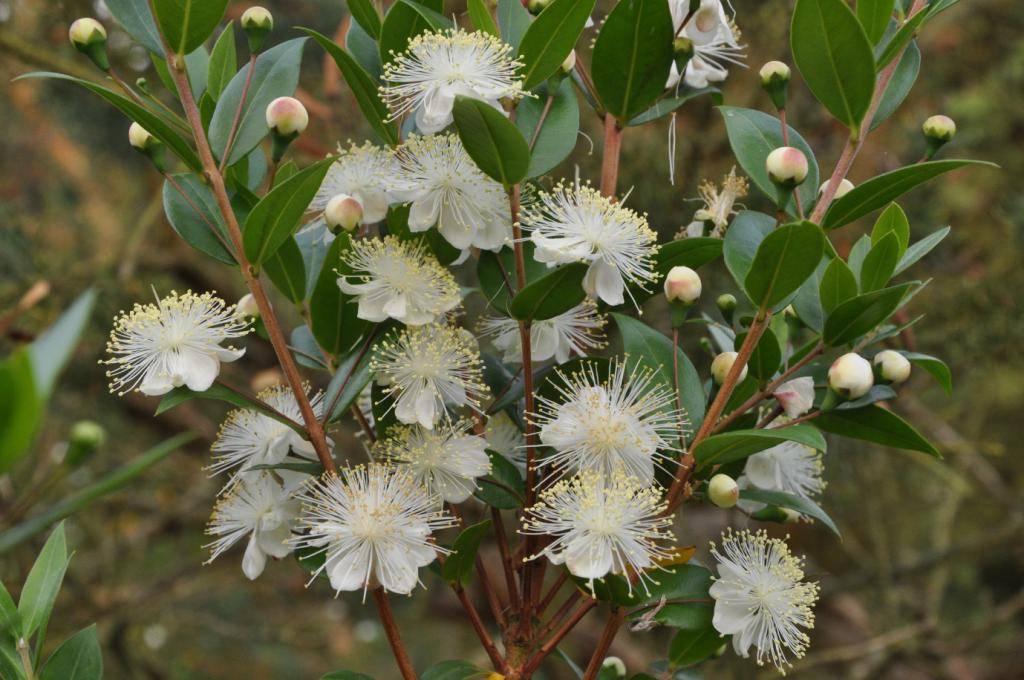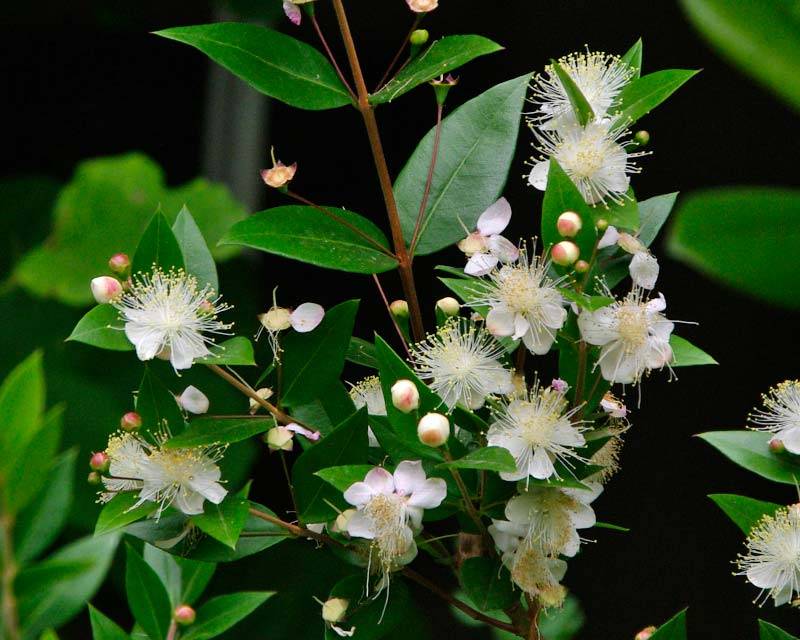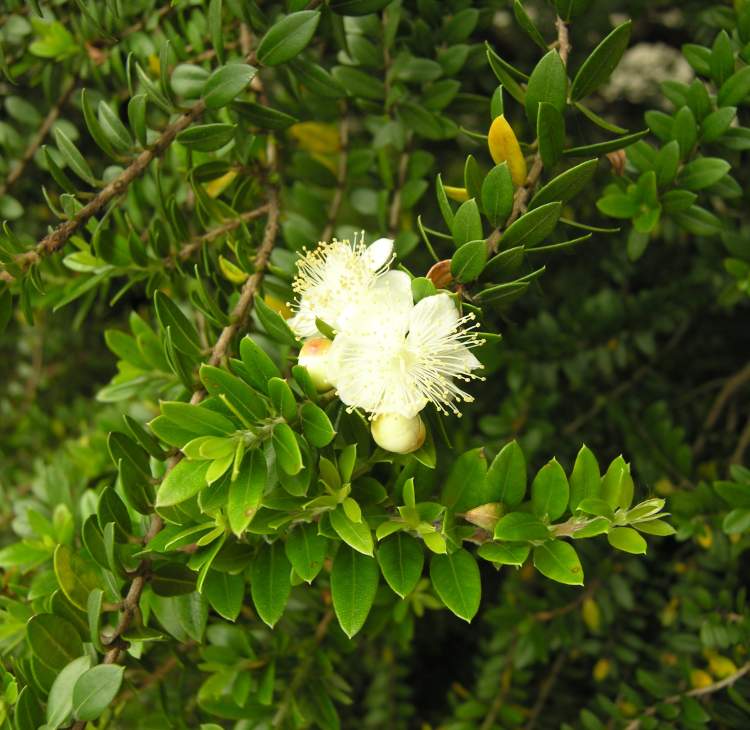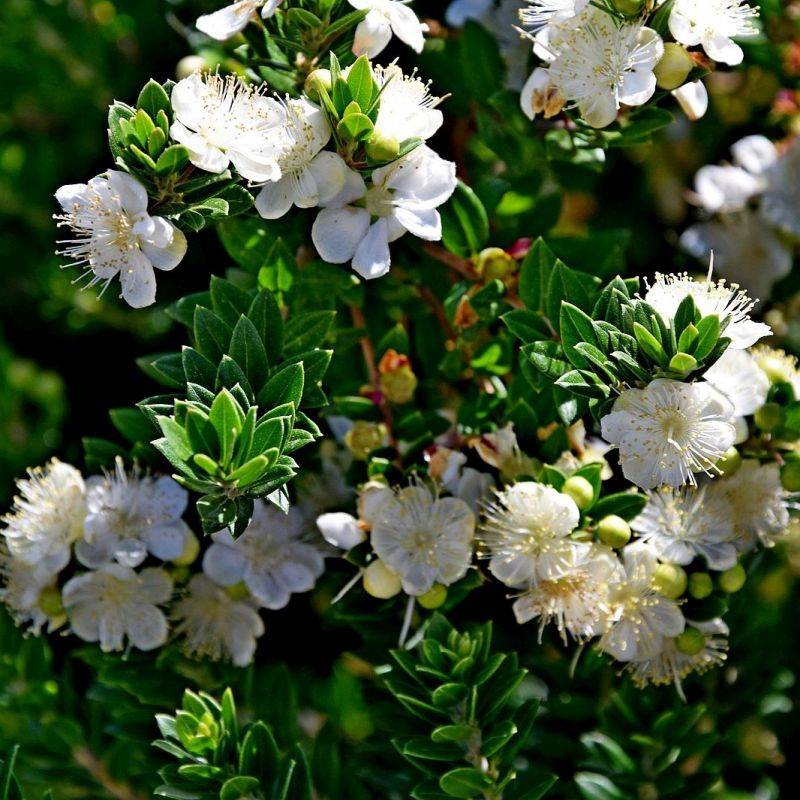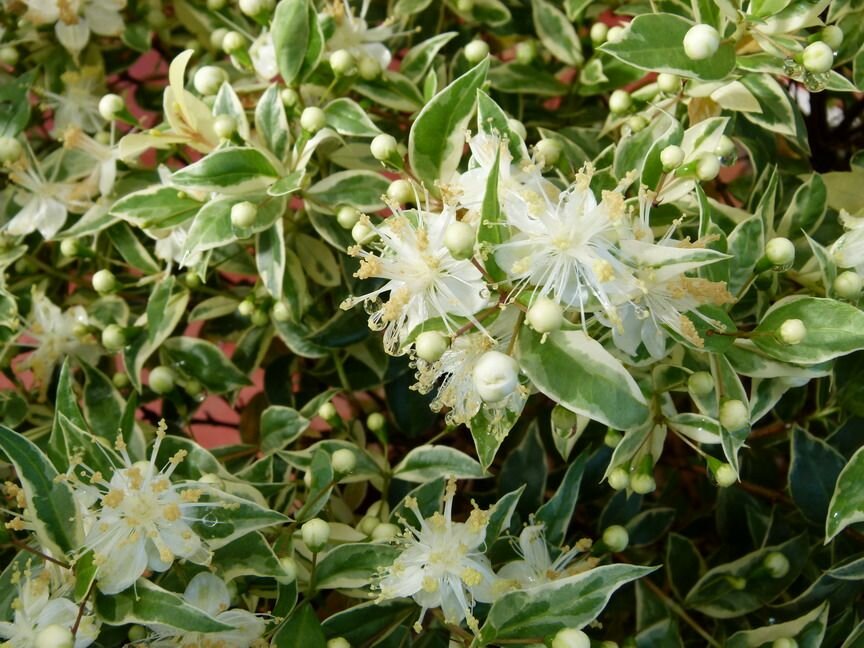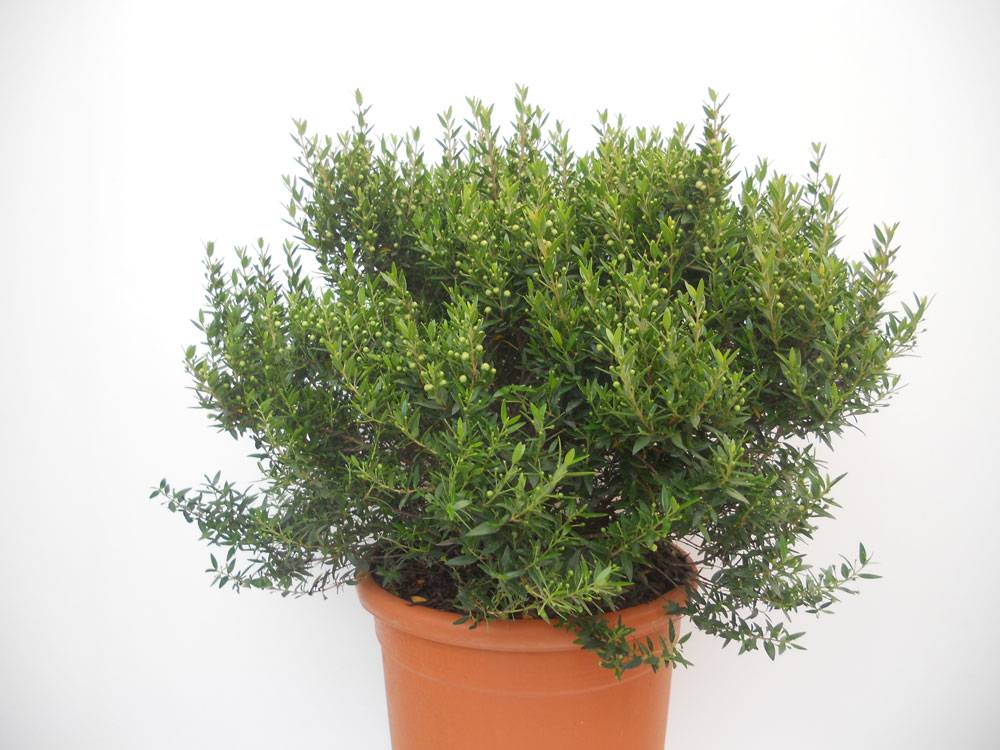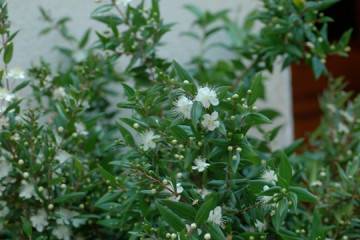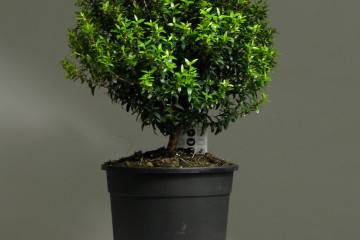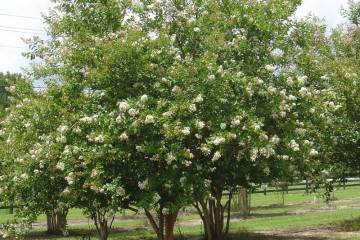Myrtle - home care, how to reanimate if it has dried up
Content:
Myrtle is a beautiful home plant that has a pleasant aroma and can delight its owners with a pleasant flowering. Having chosen myrtle, caring for a flower at home will not be difficult. Of course, a number of conditions will be required, but there are no difficulties in such care. This plant can be enjoyable and beneficial for many years.
The origin and appearance of the myrtle tree
The genus myrtle includes more than 110 species of shrubs and small trees. The smallest of them are firmly rooted in the homes of amateur flower growers.
In any home flower garden, this plant will be able to find its place. Thanks to its aromatic and medicinal properties, the tree is known to soothe the nervous system, as well as create a favorable aura in the home.
Descriptions of the plant myrtle
Such a tree can grow up to 5 m in height. And it's hard to believe in it, because home bushes do not grow more than 60 cm.
The myrtle tree is different:
- small shiny and strong oval-shaped leaves with a pointed tip;
- flowers rich in essential oils, which are white and pinkish;
- fruits that, depending on the variety, are white or dark purple in color.
The advantages of a flower include:
- essential oils with their antibacterial, anti-stress and anti-allergic effects;
- leaves and flowers are suitable for creating decoctions for the care of the skin of the face and scalp;
- dried fruits and twigs are widely used in cooking.
How myrtle blooms
Myrtle begins to bloom in May, and then the entire area becomes enveloped in a pleasant aroma. Some of the species bloom in September, others a little earlier, at the end of August. There are many long stamens on the flowers, which create a fluffy effect. The diameter of the flower itself is small, only 2 cm.
Types and varieties
Breeders have managed to breed many varieties of myrtle, each of which has its own distinctive features. The most popular are the following ones.
Common myrtle (Myrtus communis)
This variety is most often grown at home. It is compact in size, grows quickly and fits well into any interior. On the trunk there is bark that looks like scales and sometimes flakes off. Leaves are dense, oval, shiny. The flowers are white, with many long stamens. A beautiful voluminous bush can be formed from a tree.
Myrtle of Tarentine
The variety is bred as a dwarf species of common myrtle. It differs only in its miniature size (the leaves do not grow more than one and a half centimeters) and flowers that grow in inflorescences.
Myrtle Alhambra
This variety has dense leaves with a high content of essential oils. There are a lot of flowers, they have a pinkish tint. The fruits are white.
Myrtle Variegata
It differs from other varieties in its unusual leaf color. There is a golden border around the edges of the dark green foliage. There may be light spots in the middle of the leaf, forming a crown.
Myrtle La Clape
Its fruits, unlike other varieties, are purple in color.
Myrtle Microphylla
A small-leaved variety of very compact size, it reaches a height of no more than 60 cm. The leaves grow very densely, the young ones differ from the old ones in a lighter color.
Transplanting myrtle after buying into a pot
How to grow myrtle if it is a rather picky plant that does not like stress, moving and replanting? When caring for him, you need to follow several rules:
- after purchase, wait for a while, and do not transplant immediately. So the plant will be able to adapt and not shed the leaves from the stress associated with movement;
- control humidity. Myrtle should not lack this. If the appearance suggests otherwise, then you can place the flower under the plastic to create a greenhouse effect. You can keep it in this form for a month, taking small breaks daily;
- place the pot of myrtle in partial shade. It is especially important to take care of the plant so that during the adaptation period the flower does not come into direct sunlight;
- monitor the absence of drafts. Myrtle does not tolerate them, especially when it gets into new conditions.
What is needed for landing
Myrtle grows up to 3-4 years old, so when this age is reached, there is no need to transplant the flower into a larger pot. The process must be carried out in compliance with the following conditions:
- the soil must be selected light and loose. You can purchase a ready-made flower mixture, which contains crushed peat or sand;
- the pot should be slightly larger than the root system, and holes for drainage are required at the bottom;
- pebbles, ceramic or brick chips can be used as drainage.
Choosing the best place
After transplanting, myrtle needs to adapt in a dark and cool place. For a permanent presence, a well-lit window sill is suitable, which does not receive direct sunlight, otherwise the leaves may begin to curl. You need to move the pot of myrtle there gradually. The best window will be the southwest or southeast, the north side can provoke a slowdown in plant growth.
Step-by-step planting process
The procedure for planting myrtle should look like this:
- Prepare the pot, soil, drainage and sterilize them.
- Wait for the soil to dry out. Then it will be easier to remove the root system from the old container.
- Place the drain on the bottom of the pot so that it fills up to a third.
- Gently brush off old clods of soil with a stick to straighten the root system around the edges.
- Go through the roots, remove dry and rotten ones, treat the affected areas with coal dust or root roots.
- Place the myrtle in a pot and root by sprinkling and lightly tamping the soil with your fingers.
After transplanting, to adapt to the new pot, spraying and irrigation of myrtle is carried out. You can use epin, a flower growth stimulant.
Once the plant has sprouted freshly, it can be placed in its permanent location.
Reproduction of myrtle at home
How to propagate myrtle is a question that interests many. Do this using cuttings or seeds.The last method is a laborious and lengthy process. According to the experience of florists, it is better to use cuttings.
Propagation by cuttings
Myrtle cuttings are carried out in the following way:
- Choose a suitable time: mid-winter or mid-summer, any other time is not suitable for this procedure.
- Cut the cuttings from the middle of the plant so that their length is 7-8 cm.
- Remove some of the leaves from the bottom of the cutting, so as not to waste excess moisture.
- Treat the cut end with a growth stimulant.
- Pick up a soil for planting a cutting from a mixture of sand and moss, ordinary soil is also suitable.
- Provide suitable conditions for the seedling: shade, temperature ranging from 15 ° C to 20 ° C, high humidity. You can create a greenhouse effect, but the plants need to be ventilated every day. In a month, the new seedling will form its roots and will be ready for transplanting.
Growing from seeds
It is possible to grow myrtle from seeds for a long time and carefully, but this will be a more troublesome process.
How myrtle reproduces from seeds:
- Soak seeds in potassium permanganate solution for 1.5-2 hours.
- Prepare a light substrate of sand and peat so that the seeds can breathe easily.
- Place them in the substrate no deeper than 5 mm, moisten with a spray bottle.
- Create a greenhouse effect with polyethylene, periodically opening it during ventilation.
- Remove the film when the seeds hatch after 6-8 weeks.
- Transplant the seedlings into separate containers.
- When the shoots grow and give more than two leaves, the top is pinched off to provoke the growth of lateral shoots.
Myrtle care
Caring for a myrtle tree at home is a certain amount of attention and adherence to the rules. It is necessary to know them so that you do not have to be upset when wondering why the bush began to shed its leaves or stopped blooming.
Watering mode
Myrtle loves moisture, the soil in the pot should always remain moist, it should not be allowed to dry. It is especially important to monitor the moisture supply during periods of flower activity. The plant will signal a lack of water by dropping leaves.
If the myrtle has dried up, many flower growers do not know how to reanimate. Can be supplemented with spray watering and warm showers. But without good drainage, myrtle roots can start to rot.
Top dressing
With a good feeding regime, the myrtle tree will grow faster and produce more flowers. Mineral complexes work well, but care must be taken that they do not contain calcium. Feeding can be done 1-2 times a week.
Features of care during flowering
In order for myrtle to please with abundant flowering, it must receive high-quality care conditions. If the plant does not bloom and does not form ovaries, then this may be influenced by the following reasons:
- lack of moisture;
- sudden movement of the plant to the wrong light;
- pruning shoots at the wrong time: you can prune either in winter or immediately after flowering;
- insufficient feed;
- diseases and pests.
Features of care during the rest period
In winter, when the plant is dormant, watering is reduced only when the soil is dry 1-2 cm deep. Spraying is not required at this time.
Top dressing is also reduced to once every 1.5-2 months.
During this period, it is important to protect the plant from low temperatures, the tree does not tolerate them well.From 8 ° С to 10 ° С - ideal conditions for wintering, a different temperature regime can negatively affect the future flowering of the bush.
Preparing for winter
For the winter period, it is better to transfer the plant to a balcony or loggia, so it will receive enough light, but at the same time it will not overheat. It is only important that it does not fall into drafts, otherwise the leaves will begin to fall off. If this is not possible, then a humidifier is installed next to the myrtle bush.
Myrtle is a rather capricious and demanding plant. But if you follow all the rules for caring for it and not expose it to the negative influence of surrounding factors, it will be able to please the owners with a healthy and lush color, and will also give all its useful properties.
